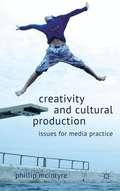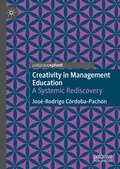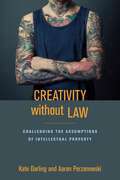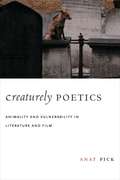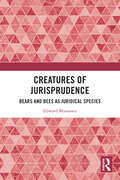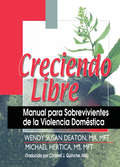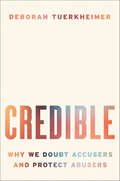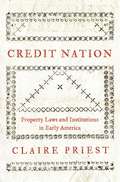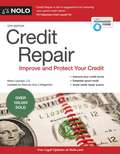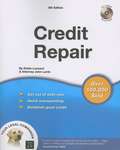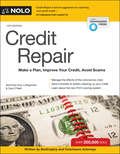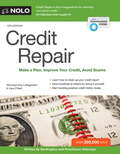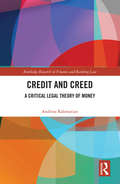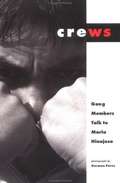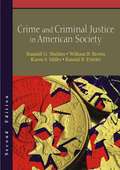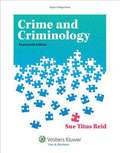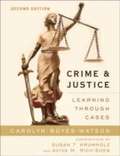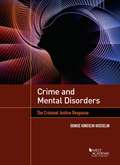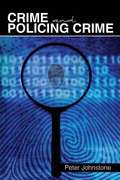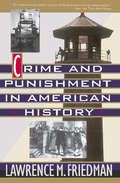- Table View
- List View
Creativity and Copyright: Legal Essentials for Screenwriters and Creative Artists
by Howard Suber John L. GeigerInspired by Strunk & White's The Elements of Style, this elegant, short reference is the perfect guide for screenwriters and creative artists looking to succeed as industry professionals. Readers will quickly understand the laws that govern creativity, idea-making, and selling, and learn how to protect themselves and their works from the legal quagmires they may encounter. Written by an unrivaled pair of experts, John L. Geiger and Howard Suber, who use real-life case studies to cover topics such as clearance, contracts, collaboration, and infringement, Creativity and Copyright is poised to become an indispensable resource for beginners and experts alike.
Creativity and Cultural Production
by Phillip McintyrePhillip McIntyre brings a new understanding to the issues plaguing copyright industries as they struggle with the digital revolution. Applying research coming out of psychology, sociology, communication and cultural studies to look at television, radio, film, journalism, photography, popular music and new media, this groundbreaking book providesuseful insights to media practitioners as they go about their creative practice. Italso gives policy professionals concerned with creativity and innovation a solid research-based understanding of cultural production, andgoes well beyond common sense thinking about creativity, seeing it instead as a system in operation. In short, this bookwill change your mind about creativity. "
Creativity and Its Discontents: China’s Creative Industries and Intellectual Property Rights Offenses
by Laikwan PangCreativity and Its Discontents is a sharp critique of the intellectual property rights (IPR)-based creative economy, particularly as it is embraced or ignored in China. Laikwan Pang argues that the creative economy--in which creativity is an individual asset to be commodified and protected as property--is an intensification of Western modernity and capitalism at odds with key aspects of Chinese culture. Nevertheless, globalization has compelled China to undertake endeavors involving intellectual property rights. Pang examines China's IPR-compliant industries, as well as its numerous copyright violations. She describes how China promotes intellectual property rights in projects such as the development of cultural tourism in the World Heritage city of Lijiang, the transformation of Hong Kong cinema, and the cultural branding of Beijing. Meanwhile, copyright infringement proliferates, angering international trade organizations. Pang argues that piracy and counterfeiting embody the intimate connection between creativity and copying. She points to the lack of copyright protections for Japanese anime as the motor of China's dynamic anime culture. Theorizing the relationship between knockoffs and appropriation art, Pang offers an incisive interpretation of China's flourishing art scene. Creativity and Its Discontents is a refreshing rejoinder to uncritical celebrations of the creative economy.
Creativity in Management Education: A Systemic Rediscovery
by José-Rodrigo Córdoba-PachónThis book proposes a new way to consider creativity in management education, inviting educators to rediscover themselves in the process. To date, creativity in management is a valuable skill, but one which has been institutionalized and subordinated to metrics such as economic growth, knowledge disciplining and employability. After a critical analysis using Foucault’s governmentality to identify how creativity is being organized in management education, this book examines diverse initiatives intended to nurture creativity. Then, and through a systemic recontextualization of governmentality and other notions like play, it provides conceptual and practical guidance derived from the author’s own self-narratives (games) as student and educator. The book concludes with important reflections, implications and guidelines for the nurturing in creativity in management education and life in general. This book will be a valuable reading for creativity and innovation scholars, academics working in management education and students in general.
Creativity without Law: Challenging the Assumptions of Intellectual Property
by Kate Darling Aaron PerzonowskiBehind the scenes of the many artists and innovators flourishing beyond the bounds of intellectual property laws Intellectual property law, or IP law, is based on certain assumptions about creative behavior. The case for regulation assumes that creators have a fundamental legal right to prevent copying, and without this right they will under-invest in new work. But this premise fails to fully capture the reality of creative production. It ignores the range of powerful non-economic motivations that compel creativity, and it overlooks the capacity of creative industries for self-governance and innovative social and market responses to appropriation. This book reveals the on-the-ground practices of a range of creators and innovators. In doing so, it challenges intellectual property orthodoxy by showing that incentives for creative production often exist in the absence of, or in disregard for, formal legal protections. Instead, these communities rely on evolving social norms and market responses—sensitive to their particular cultural, competitive, and technological circumstances—to ensure creative incentives. From tattoo artists to medical researchers, Nigerian filmmakers to roller derby players, the communities illustrated in this book demonstrate that creativity can thrive without legal incentives, and perhaps more strikingly, that some creative communities prefer, and thrive, in environments defined by self-regulation rather than legal rules. Beyond their value as descriptions of specific industries and communities, the accounts collected here help to ground debates over IP policy in the empirical realities of the creative process. Their parallels and divergences also highlight the value of rules that are sensitive to the unique mix of conditions and motivations of particular industries and communities, rather than the monoculture of uniform regulation of the current IP system.
Creaturely Poetics: Animality and Vulnerability in Literature and Film
by Anat PickSimone Weil once wrote that "the vulnerability of precious things is beautiful because vulnerability is a mark of existence," establishing a relationship between vulnerability, beauty, and existence transcending the separation of species. Her conception of a radical ethics and aesthetics could be characterized as a new poetics of species, forcing a rethinking of the body's significance, both human and animal. Exploring the "logic of flesh" and the use of the body to mark species identity, Anat Pick reimagines a poetics that begins with the vulnerability of bodies, not the omnipotence of thought. Pick proposes a "creaturely" approach based on the shared embodiedness of humans and animals and a postsecular perspective on human-animal relations. She turns to literature, film, and other cultural texts, challenging the familiar inventory of the human: consciousness, language, morality, and dignity. Reintroducing Weil's elaboration of such themes as witnessing, commemoration, and collective memory, Pick identifies the animal within all humans, emphasizing the corporeal and its issues of power and freedom. In her poetics of the creaturely, powerlessness is the point at which aesthetic and ethical thinking must begin.
Creaturely Poetics: Animality and Vulnerability in Literature and Film
by Anat PickSimone Weil once wrote that "the vulnerability of precious things is beautiful because vulnerability is a mark of existence," establishing a relationship between vulnerability, beauty, and existence transcending the separation of species. Her conception of a radical ethics and aesthetics could be characterized as a new poetics of species, forcing a rethinking of the body's significance, both human and animal. Exploring the "logic of flesh" and the use of the body to mark species identity, Anat Pick reimagines a poetics that begins with the vulnerability of bodies, not the omnipotence of thought. Pick proposes a "creaturely" approach based on the shared embodiedness of humans and animals and a postsecular perspective on human-animal relations. She turns to literature, film, and other cultural texts, challenging the familiar inventory of the human: consciousness, language, morality, and dignity. Reintroducing Weil's elaboration of such themes as witnessing, commemoration, and collective memory, Pick identifies the animal within all humans, emphasizing the corporeal and its issues of power and freedom. In her poetics of the creaturely, powerlessness is the point at which aesthetic and ethical thinking must begin.
Creatures of Jurisprudence: Bears and Bees as Juridical Species
by Edward MussawirTo what extent can an animal constitute a ‘juridical species’? This highly original book considers how animals have been integral to law and to legal thinking.Going beyond the traditional approaches to animal rights and the question of whether non-human animals may be considered legal ‘subjects,’ this book follows two types of animal – bears and bees – and asks what existence these species have maintained in juridical thought. Uncovering surprising roles that the animals play in the imagination of and solution to jurisprudential problems, the book offers a counter-argument to the view that juridical thought reduces one’s appreciation for the singularity and independence of their lives. It shows, rather, that the animals exert a remarkable influence on the creative dimensions of law, offering a liveliness to it that is worthy of close attention.Contributing to new directions at the intersection of jurisprudence and human–animal studies, this book will appeal to those with interests in either of these areas.
Creciendo Libre: Manual para Sobrevivientes de la Violencia Doméstica
by Michael Hertica Wendy Deaton Christell QuincheHelp your Spanish-speaking clients break the pattern of abuse! A workbook for your Spanish-speaking clients! Battered women often become so frightened, isolated, and self-doubting that they don&’t realize that they are being victimized. They may minimize the seriousness of the abuse and make excuses for the abuser. The checklists, questionnaires, and personal stories in Creciendo Libre can provide the shock of recognition they need to be able to say, "This is wrong. It has to end." Combining psychological insight with practical safety information, Creciendo Libre helps the reader to understand-and end-the vicious cycle of wooing, tension, violence, and remorse that characterizes all levels of domestic violence. It outlines a series of steps abused women can take to ensure their emotional and physical safety. Creciendo Libre offers both practical and psychological resources, including: lists of abusive behaviors from ridiculing family members to physical violence common rationalizations for abuse used by both victims and perpetrator detailed discussions of protection orders and other legal matters detailed preparations and safety precautions that may make leaving less dangerous advice on what to take with you when you leave guidelines for establishing safe relationships in the future Creciendo Libre provides readers with a straightforward, action-oriented approach to the problem of domestic violence. A companion volume available separately, A Therapist&’s Guide to Growing Free (available in English only), offers therapists a comprehensive outline of the issues, tasks, and goals involved in treatment with victims and survivors. Rompe el patrón del abuso-de una manera segura! Mujeres abusadas muchas veces llegan a temer, aislarse, y a auto dudarse al punto que no logran reconocer que estan siendo victimizadas. Ellas podran minimizar la seriedad del abuso y hacer excusas para encubrir al ofensor. Las listas, cuestionarios, y relatos personales en Creciendo Libre pueden proveer el susto necesario para que ellas reconozcan que, "Esto esta mal y tiene que terminar." Combina la revelación psicologica e información practica, para ayudar a que el lector de Creciendo Libre pueda entender y parar-el ciclo vicioso del cortejo, la tension, la violencia, y la culpabilidad que caracteriza todos los niveles de la violencia doméstica. Este libro delinea una serie de pasos para que la mujer abusada llege ha asequrar su seguridad emocional y física. Creciendo Libre ofrece recursos practicos y psicologicos incluyendo: listas de comportamientos abusivos desde la rediculización de los miembro de la familia hasta la violencia física racionalizaciones del abuso comunmente utilizadas por la victima y el ofensor una explicación detalladas sobre la orden de protección y otros asuntos legales preparación y medidas de precaución detalladamente explicados que puedan hacer que el irse sea menos peligroso consejos sobre lo que se debe llevar cuando decida irse guías para establezer una relación segura en un futuro Creciendo Libre provee al lector un metodo directo, orientado al la acción para resolver problemas sobre la violencia doméstica. El volumen que le acompaña esta separadamente disponible. El Guia del Terapeuta de Creciendo Libre, ofrece un esquema comprensivo de los asuntos, tareas, y metas impuestas en el tratamiento de las victimas y sobrevivientes.
Credible: Why We Doubt Accusers and Protect Abusers
by Deborah TuerkheimerIn this landmark book, a former prosecutor, legal expert, and leading authority on sexual violence examines why we are primed to disbelieve allegations of sexual abuse—and how we can transform a culture and a legal system structured to dismiss accusers Sexual misconduct accusations spark competing claims: her word against his. How do we decide who is telling the truth? The answer comes down to credibility. But as this eye-opening book reveals, invisible forces warp the credibility judgments of even the well- intentioned among us. We are all shaped by a set of false assumptions and hidden biases embedded in our culture, our legal system, and our psyches. In Credible, Deborah Tuerkheimer provides a much-needed framework to explain how we perceive credibility, why our perceptions are distorted, and why these distortions harm survivors. Social hierarchies and inequalities foster doubt that is commonplace and predictable, resulting in what Tuerkheimer calls the “credibility discount”—our dismissal of claims by certain kinds of speakers—primarily women, and especially those who are more marginalized. The #MeToo movement has exposed how victims have been badly served by a system that is designed not to protect them, but instead to protect the status quo. Credibility lies at the heart of this system. Drawing on case studies, moving first-hand accounts, science, and the law, Tuerkheimer identifies widespread patterns and their causes, analyzes the role of power, and examines the close, reciprocal relationship between culture and law—guiding us toward accurate credibility judgments and equitable treatment of those whose suffering has long been disregarded.#MeToo has touched off a massive reckoning. To achieve lasting progress, we must shift our approach to belief. Credible helps us forge a path forward to ensuring justice for the countless individuals affected by sexual misconduct.
Credit Nation: Property Laws and Institutions in Early America (The Princeton Economic History of the Western World #104)
by Claire PriestHow American colonists laid the foundations of American capitalism with an economy built on creditEven before the United States became a country, laws prioritizing access to credit set colonial America apart from the rest of the world. Credit Nation examines how the drive to expand credit shaped property laws and legal institutions in the colonial and founding eras of the republic.In this major new history of early America, Claire Priest describes how the British Parliament departed from the customary ways that English law protected land and inheritance, enacting laws for the colonies that privileged creditors by defining land and slaves as commodities available to satisfy debts. Colonial governments, in turn, created local legal institutions that enabled people to further leverage their assets to obtain credit. Priest shows how loans backed with slaves as property fueled slavery from the colonial era through the Civil War, and that increased access to credit was key to the explosive growth of capitalism in nineteenth-century America.Credit Nation presents a new vision of American economic history, one where credit markets and liquidity were prioritized from the outset, where property rights and slaves became commodities for creditors' claims, and where legal institutions played a critical role in the Stamp Act crisis and other political episodes of the founding period.
Credit Repair (12th Edition)
by Robin Leonard Amy LoftsgordonWhen debts pile up, it can be impossible to see a way out. And in the meantime, the consequences pile up. Let the sensible strategies in Credit Repair help you take control, clean up your credit report, and live debt-free. assess your debt situation correct errors and improve your credit report and score choose the best repair strategy for your situation prioritize your debts negotiate with creditors to reduce debts add positive information to your credit report avoid identity theft and credit scams build a solid credit history This edition of Credit Repair is completely updated with the latest legal developments, and includes dozens of forms and letters that will help you spruce up your credit report as easily as possible!
Credit Repair (8th edition)
by Robin Leonard John LambLeonard is an attorney and the author or co-author of many of Nolo's personal finance books. Written in plain English, his text explains how to get out of debt, set up a realistic budget, and rebuild "bad" credit. This edition has been completely updated and revised to incorporate the latest information and laws, including new information on identity theft and what to do if you are a victim of it. The text includes 30 forms and letters, both as tear-outs and on the accompanying CD-ROM. Annotation ©2006 Book News, Inc., Portland, OR (booknews.com)
Credit Repair: Make a Plan, Improve Your Credit, Avoid Scams
by Amy Loftsgordon Cara O'NeillBad credit can get better A bad credit report can prevent you from getting a mortgage, car loan, credit card, apartment, or even a job. The sensible strategies in Credit Repair help you take control of your finances, clean up your credit report and rebuild your credit. Learn how to: prioritize debts and create a budget reduce debts and cut expenses negotiate with creditors correct credit report errors and remove old information add positive information to your credit report adopt strategies to rebuild your credit, and avoid identity theft and credit repair scams. Updates to the 14th edition of Credit Repair include the new FICO scoring system and federal CARES Act credit reporting guidelines, changes to credit freeze and fraud alert laws, the availability of additional free credit reports during the pandemic, and more. With downloadable forms: Get forms, worksheets, and sample letters—to help you handle debts, clean up your credit, and avoid overspending (details inside).
Credit Repair: Make a Plan, Improve Your Credit, Avoid Scams (13th Edition)
by Robin Leonard Amy Loftsgordon<p>Bad credit can prevent you from getting a mortgage, car loan, credit card, apartment, or even a job. It can also mean paying a bundle in rates and fees for any loans or credit you do get. <p>Use this comprehensive how-to manual to rebuild bad credit and protect improved credit. Learn how to: <p> <li>reduce expenses <li>create a workable budget <li>negotiate with creditors <li>improve your credit score, and <li>protect yourself against identity theft</li> </p>
Credit and Creed: A Critical Legal Theory of Money (Routledge Research in Finance and Banking Law)
by Andreas RahmatianMoney is a legal institution with principal economic and sociological consequences. Money is a debt, because that is how it is conceptualised and comes into existence: as circulating credit – if viewed from the creditor’s perspective – or, from the debtor’s viewpoint, as debt. This book presents a legal theory of money, based on the concept of dematerialised property. It describes the money creation or money supply process for cash and for bank money, and looks at modern forms of money, such as cryptocurrencies. It also shows why mainstream economics presupposes, but avoids an analysis of, money by effectively eliminating money from the microeconomic market model and declaring it as merely a neutral medium of exchange and unit of account. The book explains that money rather brings about and influences substantially the exchange or transaction it is supposed to facilitate only as a neutral medium. As the most liquid of all assets, money enables financialisation, monetisation and commodification in the economy. The central role of the banks in the money creation process and in the economy, and their strengthened position after the bank rescue measures in the wake of the financial crisis 2008-9 are also discussed. Providing a rigorous analysis of the most salient legal issues regarding money, this book will appeal to legal theorists, economists and anyone working in commercial or banking law.
Credit, Consumers and the Law: After the global storm (Markets and the Law)
by Paul O'Shea Ross Grantham Karen FairweatherConsumer law, particularly consumer credit law, is characterised by increasingly complex regulation in Western economies. Reacting to the Global Financial Crisis, governments in the UK, the EU, Australia, New Zealand and the United States have adopted new laws dealing with consumer credit, responsible lending, consumer guarantees and unfair contracts. Drawing together authors from all of these jurisdictions, this book analyses and evaluates these initiatives, and makes predictions as to their likely success and possible flaws.
Crews: Gang Members Talk to Maria Hinojosa
by Maria HinojosaHinojosa, a radio reporter, interviews boys and girls who have formed a 'crew'. They feel that it is better to be together than to be with family as they are feared more than respected.
Cricket and the Law: The Man in White is Always Right (Routledge Studies in Law, Society and Popular Culture)
by David FraserCricket, law and the meaning of life ... In a readable, informed and absorbing discussion of cricket’s defining controversies – bodyline, chucking, ball-tampering, sledging, walking and the use of technology, among many others – David Fraser explores the ambiguities of law and social order in cricket. Cricket and the Law charts the interrelationship between cricket and legal theory – between the law of the game and the law of our lives – and demonstrates how cricket’s cultural conventions can escape the confines of the game to carry far broader social meanings. This engaging study will be enjoyed by lawyers, students of culture and cricket lovers everywhere.
Crime And Criminal Justice In American Society
by Randall G. Shelden Karen S. Miller William B. Brown Randal B. FritzlerToday’s headlines vividly illustrate the importance of understanding aspects of the criminal justice system too often ignored. While the second edition of Crime and Criminal Justice in American Society includes the most recent statistics on the police, courts, and corrections, its provocative, current examples also spur critical thinking about justice in the United States. <p><p> The authors offer an alternative interpretation of criminal justice rarely presented in traditional textbooks or by the media. They encourage readers to examine their beliefs about crime, punishment, and the law. Discussions in the chapters about how African Americans, Hispanics, whites, women, juveniles, the rich, and the poor experience crime and the criminal justice system contribute context for understanding different viewpoints. The poor and minorities are the most likely to be caught in the net of criminal justice—but inequities have consequences for everyone. Reflection on various perspectives provides helpful input for assessing attitudes and for becoming actively involved with issues that have significant consequences.
Crime And Criminology, 14th Edition
by Sue Titus ReidProviding a unique blend of social science and legal research, Crime and Criminology offers students a broad context in which to study this dynamic subject, from its history and theories to its ongoing debates and discussions. Features: Provides students with a solid understanding of the integral relationship between the law and theories of criminal behavior Recent updates include the impact of terrorism and the economic downturn on the criminal justice system, victims with disabilities, healthcare and Medicare fraud, and the decriminalization of marijuana for personal use Expanded coverage of rehabilitation and deterrence, statutory rape, elder abuse, domestic violence, intimate partner violence, hate crimes, gun control, property crimes, and more Presents new research on families, twins, adoptees, and how brain function may be used to explain criminal behavior Integrates engaging pedagogy throughout
Crime And Justice: Learning Through Cases
by Carolyn Boyes-Watson Susan T. Krumholz Aviva M. Rich-SheaCrime and Justice offers a comprehensive introduction to the U. S. criminal justice system through nineteen historical and contemporary case studies. Each chapter opens with an engaging case, followed by an explanatory chapter that teaches core concepts, key terms, and critical issues. The second edition has been revised and updated throughout. It features new chapters on terrorism, the war on drugs, and gender. It also expands coverage of white collar crime and victims issues. New cases include Enron, the O. J. Simpson trial, Barbara Sheehan and Battered Women s Defense, the story of Al Capone, and more. In this second edition, Carolyn Boyes-Watson, with contributors Susan T. Krumholz and Aviva M. Rich-Shea, enhance student learning through case studies that serve multiple learning objectives: cases explore sociological issues of race, class, gender, and power, while also teaching students the law and processes of the justice system. The book is excellent for not just Introduction to Criminal Justice courses, but also any course that introduces students to the concepts of crime and justice.
Crime And Mental Disorders: The Criminal Justice Response (Higher Education Coursebook)
by Denise Gosselin<p>The newest entry in the cutting edge topic of Mental Illness and Crime, this book from Denise Gosselin is practically focused and straightforward in its approach. It's clear, concise writing style avoids jargon and will engage both undergraduate and graduate students. It includes discussions of understanding mental illness, the changing landscape of criminal justice and mental illness, criminal justice responses to mental illness, alternatives to incarceration and global issues. An accompanying website includes Test Banks and other instructional materials. <p>Organized into five sections: <p> <li>Part I UNDERSTANDING MENTAL ILLNESS concern the history (past and present), classifications, and introduction to the criminal justice issues on the responses to people with mental illness. <li>Part II THE CHANGING LANDSCAPE examines the criminal justice involved encounters that occur outside of the traditional system, involving intervention, collaboration, and civil commitment. <li>Part III CRIMINAL JUSTICE RESPONSES look at law and policy of law enforcement, the criminal court and corrections. <li>Part IV ALTERNATIVES TO INCARCERATION reflects recent changes to reentry and community corrections. The juvenile justice component includes the brief system responses to juveniles with mental disorders. <li>Part V GLOBAL ISSUES stands alone as chapter 14 to remind us that we are not alone! The issues and system responses are not unique to the United States. </li> </p>
Crime And Policing Crime
by Peter JohnstoneCrime and Policing Crime covers four types of crime: assaults, missing persons, theft offences, and drug offences. It also covers the different types of police officers, such as municipal police, state law enforcement, and federal and international agencies. <p><p> Taking students back in time, Crime and Policing Crime cover how pioneers in areas of science have helped police officers to solve crimes and identify suspects.
Crime And Punishment In American History
by Lawrence FriedmanIn a panoramic history of our criminal justice system from Colonial times to today, one of our foremost legal thinkers shows how America fashioned a system of crime and punishment in its own image.

